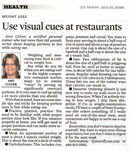 Use visual cues at restaurants Use visual cues at restaurants
Weighing and measuring your food is critical to weight loss. There is just no way to really know how many calories you are consuming without knowing how much of any particular food you are putting in your mouth.
When you are at home, you have measuring tools to help you make accurate calorie calculations, but what do you do when you are eating out? In the highly competitive restaurant market, many try to convey "value" by serving up significantly oversized portions. It is very easy to end up eating a lot more calories than you should and derail your weight loss efforts. With that in mind, here are some simple tips and tricks for keeping portion sizes in line while eating out.
Practice, Practice, Practice: You need to be familiar with what proper portion sizes look like. If you measure properly at home, you will get used to proper portions and can make more accurate estimates when you don’t have tools available.
Meat: An appropriate portion of meat is about 3 ounces cooked weight. This is about the size of a deck of cards. Keep in mind that the weight of meat listed on a restaurant menu is pre-cooked. You can assume that about 25% of that weight will be lost in the cooking process. Thus a quarter pound of hamburger will yield about 3 ounces cooked.
Carbohydrates: This includes rice, pasta, potatoes and cereal. You want to limit your serving to about a half-cup of rice or pasta and about a cup of potatoes or cereal. One cup is about the size of a baseball and a half-cup is about the size of a tennis ball.
Fats: Two tablespoons of fat is about the size of a golf ball or ping pong ball. Pure fat, such as butter or margarine, is about 100 calories for one tablespoon. Regular salad dressing can have as many as 120 calories in 2 tablespoons. These fats are one of the easiest ways that calories can sneak in while you’re eating out. So, you want to limit (or eliminate) them wherever you can.
Desserts: Ordering dessert when dining out is one sure way to make my scale move in the wrong direction. There's a reason those desserts are so tasty. When I'm actively trying to lose weight, I skip them altogether. If I'm in weight maintenance mode, I'll have a couple of bites if someone else orders something. If I really need an end-of-the-meal treat, most restaurants are happy to serve me a cup of fruit. Also, a cappuccino (regular or decaf) can often be a nice way to finish a good mea
Remember, you don't want to deprive yourself. You want to enjoy your dining experience, but you don't want to regret it for the next week while you are working off that over-indulgence. |

